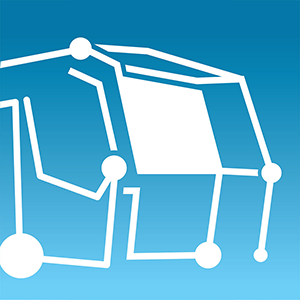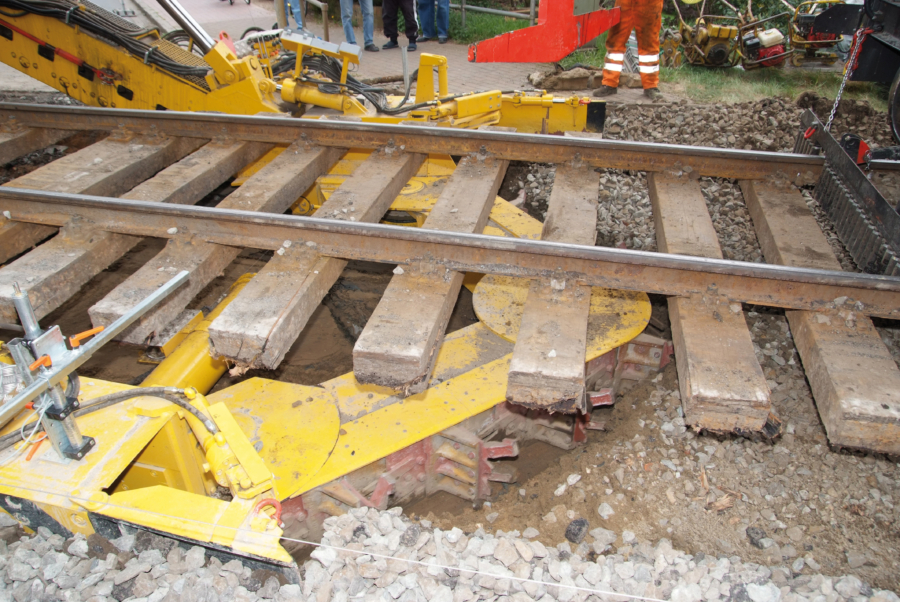
To produce a perfect, straight formation, Plasser & Theurer’s ballast cleaning machines are equipped with a transverse cutter bar to guide the excavating chain. Pivoted to hydraulic cylinders positioned horizontally and vertically, the cutter bar can be adapted exactly to the required excavating depth and formation crossfall. Moreover, it can be adjusted as necessary during operation. The optimal guidance ensures an exact and straight cut of the formation in longitudinal and transverse direction.
The design of the excavating unit makes it possible to produce the entire formation in a single pass. Excavating widths of more than 7 metres are possible. Intermediate links in the cutter bar allow varying the excavating width by 500 mm each. Quick-release fastenings enable fast execution of this work. This also enables ballast cleaning in turnouts.
To avoid obstacles, the cutter bar can be displaced laterally from its centre position without changing the formation crossfall or the cleaning depth. When working in curves, a displacement from the machine centre is also necessary to exactly position the excavating unit in the track centre.
The cleaning depth is crucial for excavating fine particles, often lying at the bottom of the ballast bed. Depending on the model, our machines reach cleaning depths of up to 1,200 mm.
The chains of the ballast cleaning machines consist of scraper plates with two to six fingers, connecting links and bolts. The fingers loosen the encrusted material. The scraper plates transport the material through the cutter bar directly up to the screening unit.
Number and position of the scraper fingers depend on the chain design, the requirements of the railway and the ballast bed condition.
When lifting up the excavated material in the cutter bar, the shape of the chain and the interaction of the scraper plates and scraper fingers play an important role to achieve a good separation already during the conveying process to the screening unit.
The standard chain height is 210 mm on an RM 76 and 290 mm on an RM 80. Special designs, such as low chains for particularly low excavating depths or narrow chains for small distances between the sleeper ends and lateral obstacles (e.g. platforms or tunnels) are available on request.
The RM 76 provides two chain speeds, the EM 80 four. This allows adjusting the speed to diverse situations in the ballast bed. The chain is powered via a chain drive gear box using a two-speed gear box or a four-speed gear box and a continuously adjustable drive pump.
The design of our ballast cleaning machines allows for other applications and working modes:
When excavating the entire ballast material, it is transported directly to the spoil conveyor belts and loaded. The full excavation of the ballast is an important working step when rehabilitating the ballast bed. If the ballast bed is highly fouled, particularly by loam, the full excavation of the ballast bed is also needed to clean it.

The hydraulically infinitely adjustable exca- vating chain adds to our standard excavating unit. Feeder plates extend the excavating width to around 5.5 m, allowing highly flexible working operation. The chain cutter bar is angled or extended. Adjusting the excavating width allows the machine to work along obstacles, such as overhead line masts, without performance losses. External rolls ensure that the chain is guided horizontally and vertically. The chain adapts to the different levels of guidance. It is not necessary to excavate an entry hole at the start of work as the rails are separated. Then, the chain automatically works through the ballast bed material. At the end of work, the process is carried out the other way around.
This excavation option is used on our high-capacity ballast cleaning machines from the RM 800 series and the formation rehabilitation and ballast cleaning machines, such as the RPM RS 900.